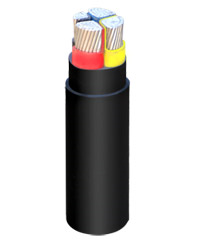
The XLPE insulated cables were introduced worldwide in mid sixties. These cables have overcome the limitations of PVC Insulated Cables such as thermal degradation, poor moisture resistant and thermoplastic in nature. XLPE means cross-linked polyethylene. Because of cross-linking, the material becomes heat resistant and does not become soft at higher temperatures. Further, it has better resistance to stress cracking and good resistance to ageing in hot air. With the change of structure there is no adverse effect on electrical properties.
XLPE insulated cables are generally manufactured up to 1000 sq. mm. (Single Core) and 630sq. mm. (Multi Core) conforming to IS, IEC & BS standards.
General Construction – LT PVC Power Cables upto 1.1 KV
The most acceptable metals for conductors are copper and aluminium due to their higher conductivity and ductility. As copper has got higher affinity for sulphur, it corrodes in the atmosphere where sulphur fumes are present. In these conditions tinned copper should be used. Aluminium oxide film which is always present on Aluminium conductor surface acts as barrier and it protects the Aluminium conductor from corrosion in fumes laden atmosphere.
The following types of conductor construction is used in manufacture of LT cables:
1)Solid/Stranded
A)Solid:
B)Stranding:
2)Circular/ Shaped
A)Circular:
B)Shaped:
A sector conductor is a conductor whose cross-section is approximately the shape of a sector of a circle. A multiple conductor insulated cable with sector conductors has a smaller diameter than the corresponding cable with round conductor. The sector shaped conductor are manufactured with pre-spiral lay which gives compact shape to the cable with reduced diameter at laid up stage.
National specifications IS:8130
International specification IEC:60228 / BS:6360
The XLPE covering over conductor is called insulation and is provided by extrusion process only. The insulated conductor is called core.
90°C thermoset dielectric, is applied as insulation over the conductor by extrusion process.
Cross Linked Polyethyelene (XLPE) as per IS 7098-1, IEC 60502-1, BS 7655.
The cores are laid up with suitable layto form a compact circular shape. The final layer always has a right hand lay i.e. if you look along the cable, the cores move to your right hand.
Inner sheath of PVC either extruded / tape is provided over the overall shield. PVC / LSZH innersheath is applied as a protection over the laid up cores and to provide a bedding for the armour. Innersheath can be offered in two forms Extruded or Taped.
A)Extruded Innersheath:
B)Tapped Innersheath:
Galvanised Steel Round Wire as per IS 3975, IEC 60502-1, BS 10257.
Galvanised Steel Flat Strip as per IS 3975, IEC 60502-1.
For Single Core cables to be used in AC circuits Aluminium Round Wire or Flat Strip armour is provided to avoid magnetic hysteresis losses.
In mines, the resistance of the armour in no case should exceed the resistance of the main core by more than 33% for safety reasons. To achieve this, sometimes tinned hard drawn copper wires are required to be used along with galvanized steel wires. Or two layers of Round Steel Wire or Steel Strip are applied in opposite direction with barrier tape in between to give extra protection.
The PVC covering over the armouring in case of armoured cables and over the Innersheath in case of unarmoured cables is called outersheath. The thickness of outer sheath is generally determine as per the relevant national and international standards. Many compounds can be used as sheath material. Different grades are available to meet specific working conditions
PVC / LSZH outersheath is applied by extrusion process and is generally black in colour (Other colour on request) with sequential length marking and required details printed with either non-contact ink jet printer or by embossing on the cable. Cables with special properties of FR and FRLS, ZH FRLS are also manufactured.
| No of Cores | Colors as per IS 7098 part 1 | Colors as per IEC 60502-1 | Colors as per BS 5467 (A:2008) |
| 1 | Red, Black, Yellow or Blue. | Red or black | Brown or blue |
| 2 | Red and Black. | Red & black | Brown & blue |
| 3 | Red, Yellow and Blue. | Red, yellow and blue | Brown black and grey |
| 3.5 | Red, Yellow, Blue and Reduced neutral Black. | ||
| 4 | Red, Yellow, Blue and Black. | Red yellow blue black | Blue, brown, black and grey |
| 5 | Red, Yellow, Blue, Black & Grey. | Red, yellow blue black and green/yellow | Green/yellow, blue, brown, black, grey |
| 6 | By printing numbers on each core. | By printing numbers on each core. | By printing numbers on each core. |